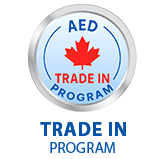CPR Overview
By now we know when someone suffers a sudden cardiac arrest (SCA), high quality CPR is a critical factor between life or death. Having an AED onsite is a must but also providing proper CPR can help survival rates.
Why Is CPR So Important?
When someone has a Sudden Cardiac arrest the heart stops beating normally, blood stops flowing to the brain and vital organs. By providing high-quality CPR keeps oxygen moving till an AED gives a shock.
What Is High Quality CPR?
High quality CPR means providing compressions at the proper depth and rate, making sure not to lean on the chest and keeping interruptions to an absolute minimum.
According to the 2015 guidelines, the American Heart association and European Resuscitation Council, they have identified five critical components to provide effective high-quality CPR.
- Compression Rate: 100-120 compressions per minute
- Compression Depth: 2-2.4 inches (5-6 cm)
- Full Chest Recoil: Allows the chest to rise fully after each push
- Minimal Interruptions: Keep pauses to a minimum
- Controlled Breathing: Avoid over ventilating during rescue breaths. (2 breaths/ 30 compressions without advanced airways) (10 breaths/minute with advanced airway)
**Remember Steady, Deep and Consistent compressions can save a life!**
Tools To Improve CPR Performance
Rescuers at every level of experience will require assistance when delivering CPR, both in and out of hospitals.
We ensure that you are set up for real-world performance, AED Solutions offers:
- AED with Real Time CPR Feedback such as ZOLL AEDs with built in coaching to help rescuers compressions
- CPR Manikins such as Prestan and Laerdal Manikins
- AED Trainers such as Defibtech, Philips, ZOLL, HeartSine and Physio Control
- Online First Aid Training with many different training options
- Maintenance Support and checks to ensure your AED is in rescue ready mode
Long-Lasting High-Quality CPR
CPR can be required for an extended period, but it is on a case-by-case basis. If the quality of CPR provided is good, data now show that patients can survive long duration CPR with good function of other organs. The ZOLL Auto Pulse is a mechanical CPR device that can provide consistent compression as it never gets tired like a human. Whether the CPR is manual or mechanical, the goal is to provide a good outcome for the patient.
1Neumar RW, et al. Circulation. 2015;132(suppl 2):S315–S367.
2Meaney PA, et al. Circulation. 2013 Jul 23;128(4):417–35. Epub 2013 Jun 25.
3Bobrow B, et al. Annals of Emergency Medicine. July 2013:62(1):47-56.31.
4Davis DP, et al. Resuscitation. 2015 Jul;92:63-69













